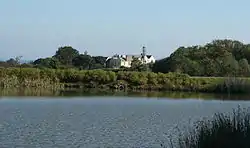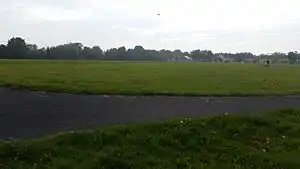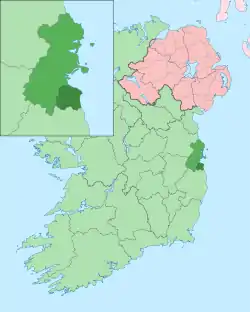Loughlinstown
Loughlinstown (Irish: Baile Uí Lachnáin, meaning "The Town of O'Loughnin") is a southern Dublin suburb, located in Dún Laoghaire–Rathdown, on the N11 national road.
Loughlinstown
Baile Uí Lachnáin | |
|---|---|
Suburb | |
 Loughlinstown Hospital | |
 Loughlinstown Location in Ireland | |
| Coordinates: 53°15′N 6°08′W | |
| Country | Ireland |
| Province | Leinster |
| County | Dún Laoghaire–Rathdown |
| Time zone | UTC±0 (WET) |
| • Summer (DST) | UTC+1 (IST) |
| Eircode routing key | D18 |
| Telephone area code | +353(0)1 |
Loughlinstown is the location of St. Columcille's Hospital, which serves both south Dublin and Wicklow. The European Foundation for the Improvement of Living and Working Conditions, an EU body, is located in Loughlinstown House.
Etymology
Loughlinstown (also Loughnanstown EME) is a derivation of the townland's ancient name, Lochan, which is said to have originally encircled a small lake[1] at the meeting of the Carrickmines River and Bride's Glen Stream.[2]
Early history
Loughlinstown was inhabited from at least the Neolithic period when the megalithic portal tomb at Cromlech Fields was constructed circa 2,500 B.C. Following Henry II's conquest of Ireland the lands around Loughlinstown were granted to the Anglo-Norman Talbot Family. By 1541 they had been granted to Goodman Family, who held them as "warden of the marches" protecting the southern border of the Pale from raids and incursions of the Wicklow Septs.[1]
A 1654 survey describes the area as containing 458 acres, of which 300 acres were the property of James Goodman, who acted as Provost Marshal of the Irish Confederate Army during the Irish Rebellion of 1641. The remaining 128 acres were the property of the Dean of Christchurch.[1][3]
Loughlinstown was granted to Sir William Domville, Attorney General for Ireland, in the reign of Charles II and James II. The Domville family held the lands for three centuries until 1962 when they were sold to Sir John Galvin.[4]
In 1975 Loughlinstown House and Commons were the subject to a Compulsory Purchase Order by then Dublin Corporation.
Recent history
The village of Loughlinstown grew up on commonage land on the Dublin to Bray high road. During the 1960s, one of the earliest stretches of dual carriageway in Ireland was built through the area, leaving the village scattered along the western side of the new road.
For years a large mature chestnut tree was located in the middle of the dual carriageway at its junction with the Wyatville Road. It was known as The Big Tree and was a landmark feature on the road from Dublin to Wicklow. In the 1970s the junction was upgraded and the tree removed. In 2004 the 1960s road was replaced with a new dual carriageway and the junction was replaced with an overbridge.
Loughlinstown Workhouse
The Rathdown Union, which was established in 1839, constructed a workhouse on 8 acres of land just south of Loughlinstown village. The institution provided 600 places for the destitute of Dundrum, Blackrock, Stillorgan, Kingstown (Dún Laoghaire), Killiney, Glencullen, Rathmichael, Powerscourt, Bray and Delgany. At the height of the Irish Famine the workhouse catered for almost 800 individuals.[5] The institution now houses St. Columcille's Hospital.

Education
There are eight primary schools in the area. In Loughlinstown, St Columbanus (Catholic, mixed);[6] in Ballybrack, St John's (Catholic, mixed), Gaelscoil Phadraig (Catholic, mixed) and Scoil Colmcille junior and senior schools (Catholic, mixed);[7][8] in Shankill, Scoil Mhuire (Catholic, mixed), Rathmichael NS (Church of Ireland, mixed) and St Anne's (Catholic, mixed).
There are three secondary schools: St Laurence College (Catholic, mixed); Holy Child Killiney (Catholic, girls) and John Scottus (interdenominational, mixed).
Transport
The Luas Green Line terminates a few minutes away from Loughlinstown, with the nearest stop being Brides Glen, which is a 40-minute journey to Dublin city centre.[9] The nearest DART station is Shankill.
The 7a (to Mountjoy Square), 84a (Blackrock to Newcastle), 145 (Heuston station to Ballywaltrim) and 155 (Ikea, Ballymun to Bray station) routes from Dublin Bus serve Loughninstown.[10] The 111 Go-Ahead Ireland route from Brides Glen to Dalkey also serves Loughninstown.[11]
References
Citations
- Ryan (1983), p. 1
- Clare (2004), p. 11
- D'Alton (1832), p. 929
- Ryan (1983), p. 12
- Clare (1986), p. 3-30
- https://www.education.ie/en/find-a-school/School-Detail/?roll=20218P
- https://www.scoilcholmcille.com/
- https://www.stcolmcillesjns.com/
- "LUAS CHERRYWOOD OPERATING HOURS, FREQUENCY AND FARES" (PDF). Luas. Retrieved 14 August 2020.
- "Timetables". Dublin Bus. Retrieved 15 August 2020.
- "111, Dalkey to Brides Glen via Dún Laoghaire". Go-Ahead Ireland. Retrieved 15 August 2020.
Bibliography
- Clare, Liam (1986), Loughlinstown Workhouse in the 1840s, Foxrock Local History Club, ISSN 0791-2870
- Clare, Liam (2004), Loughlinstown Commons Before 1870, Foxrock Local History Club, ISSN 0791-2870
- D'Alton, John (1838), The history of the county of Dublin, Hodges and Smith
- Ryan, Dr Rita (1983), Loughlinstown House, Foxrock Local History Club, ISSN 0791-2870

